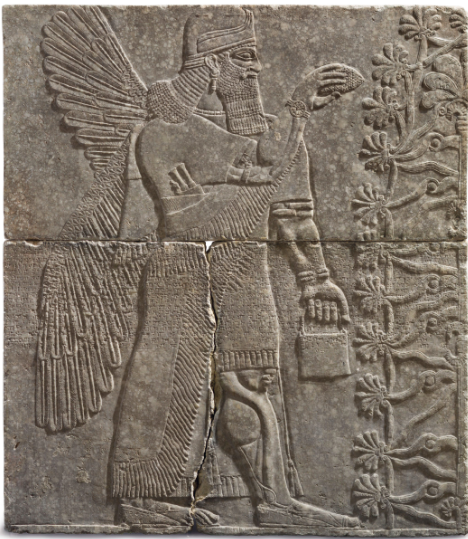VTS has announced it will auction a 3,000-year-old Assyrian sculpture, valued at between $10 million and $15 million, through Christie’s, to create a new scholarship fund with the proceeds. Reported in ARTnews:
The gypsum relief is over seven feet tall, and it once adorned the walls of the Northwest Palace of King Ashurnasirpal II at Nimrud in what is now Iraq. The figure depicted in the stone, a deity known as Apkallu, holds a bucket and a cone-shaped object that represent fertility and protection for the king.
Acquired in Mosul in 1859 by an American missionary named Henri Byron Haskell, the relief is one of the earliest ancient artworks sent to the United States. Haskell bought the work for $75 from English archaeologist Sir Austen Henry Layard, who excavated the royal palace at Nimrud—the price tag included fees for shipping the relief to Virginia. The work has been housed at the Virginia Theological Seminary since 1860. Haskell sent five additional objects to his alma mater, Bowdoin College in Maine; one of them is currently part of the Metropolitan Museum of Art’s collection.
From the VTS press release:
Proceeds from the sale will underwrite Bicentennial initiatives such as the Vocations Scholarship Fund [supporting seminary education for “international students, students of color, and second-career students”], making residential seminary education more accessible to candidates who reflect the changing face of the Episcopal Church. Funds will also be used for conservation and display of a remaining pair of carvings which will be the subject of a scholarly symposium at VTS next spring.
“We are beginning to look toward our bicentennial in 2023,” said the Very Rev. Ian S. Markham, Ph.D., dean and president. “This sale and the resulting scholarship fund illustrate just two of the ways VTS is changing as we look to the next century of service to the Episcopal Church.”
The decision to sell was first prompted last year:
In 2017 a routine insurance audit revealed the value of the three tablets had more than quadrupled, raising concerns about their unsecured location in the Seminary’s Bishop Payne Library. Insurance premiums for the three tablets jumped to $70,000 per year. After months of study and consultation with students, faculty, and staff, the Board of Trustees determined to sell the largest of the three tablets.
“It was a difficult decision,” says Markham. “These are world-class treasures that have been part of Virginia Seminary’s history for over 150 years. But in the end, the Trustees felt that the cost of maintaining the entire collection would pull resources from our primary mission to educate lay or ordained leaders for the Episcopal Church.”
VTS will retain a laser reproduction of the auctioned carving for teaching purposes. Two slightly smaller tablets from the excavation will remain at the Seminary and will be the focus of a symposium tentatively titled “Reconstructing the Reliefs from the Temple of Ninurta,” planned for the spring of 2019.
More information and a short video are available at the Christie’s website.
Photo from Christie’s website.

